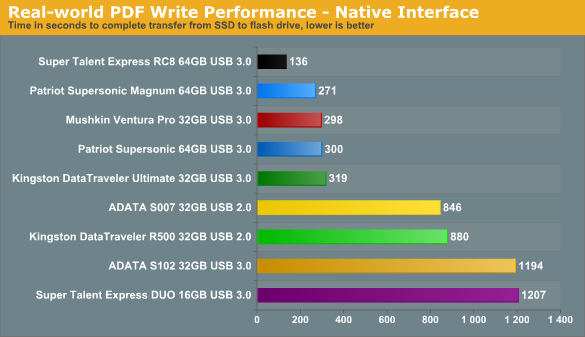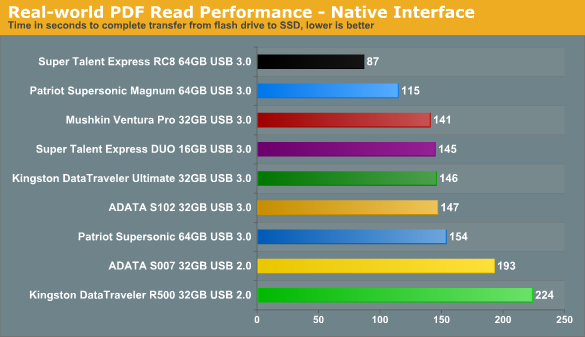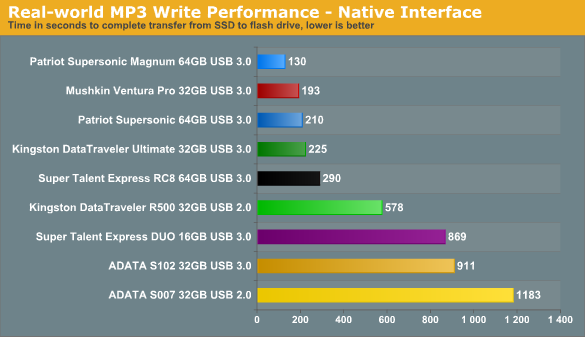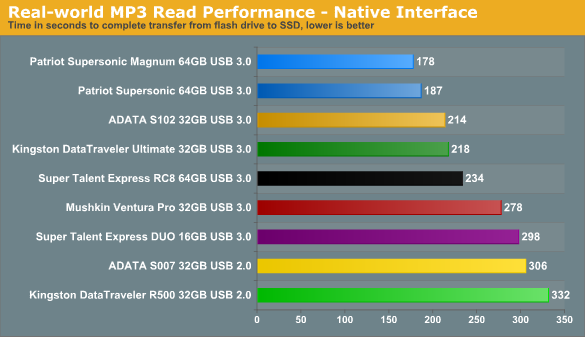USB 3.0 Flash Drive Roundup
by Zach Throckmorton on July 29, 2011 11:15 AM EST- Posted in
- Storage
- Kingston
- USB 3.0
- Patriot
- Gadgets
- ADATA
- Super Talent
- Flash Drive
- Mushkin
Real-world native interface comparisons
As described on the second page of this article, I performed a number of tests that reflect how I use flash drives. I am primarily a research scientist, and I also I love to listen to music and watch movies. Thus, flash drives in my possession are pressed into transporting three file types: small, compressible files like PDFs and office documents, MP3s, and DVD ISOs. If you are a programmer, you might be more interested in seeing how these drives fare with very small files of short pieces of code. If you are an astrophotographer, you might be interested in how flash drives handle RAW files that are hundreds of megabytes in size. As you can imagine, there are literally as many flash drive use patterns as there are folks who use flash drives, and testing them all simply is not feasible. That said, between these real-world timings and the synthetic benchmarks, you can make informed decisions when buying flash drives!

The Super Talent RC8 absolutely screams writing small, compressible files. I contacted both ADATA and Super Talent regarding the poor performance of the S102 and Express DUO, respectively, for this particular test. ADATA acknowledged the garbage collection algorithms of their S102 controller result in noticeable performance degradation during sustained writes of small files. They reported they'll be implementing new controllers in their S102 line of USB 3.0 flash drives.

The Super Talent RC8's lead is diminished but still present. If you frequently move lots of smaller files like PDFs and office documents, the RC8's the drive for you.

Patriot's Supersonic Magnum takes first place in sustained MP3 writes. The issue with the controllers of the ADATA S102 and Super Talent Express DUO continue to retard their sustained write performance of approximately 5MB file size MP3s. Also notice the Kingston R500 handily bests its USB 2.0 competitor from ADATA.

The Supersonic Magnum again produces the fastest MP3 transfer rates. If you're a mobile DJ, that's your drive!

Unsurprisingly, the four drives with the highest 100MB sequential write benchmarks in Iometer perform the best writing a single 4.2GB ISO file.

There's less than a 10% separation between the seven USB 3.0 flash drives for sustained single large file read. This chart vividly illustrates how much faster USB 3.0 can potentially be compared to USB 2.0, with the USB 3.0 drives performing more than 100% faster than their USB 2.0 counterparts. Note that we're nowhere near the theoretical transfer rate of USB 3.0 either, so future drives (and controllers) will likely be even faster.
These charts elucidate how superior Iometer synthetic benchmark performance of USB 3.0 flash drives translate into superior real-world performance. Super Talent's Express RC8 is particularly impressive in its ability to write many small, compressible files like PDFs and office documents. Writing many sub-1MB files is a pointed weakness of all flash drives, so the RC8's controller technology is aimed squarely at a glaring issue. And it hits it dead center!
The controller issue that afflicts the ADATA S102 and Super Talent Express DUO USB 3.0 flash drives during sustained smaller (i.e. <10MB) file sizes is a deal-breaker for me given my usage patterns. However, it's important to note that the performance degradation only occurs when transferring many files (the PDF and MP3 tests here each transfer thousands of files). This performance degradation does not occur when transferring a handful of files. You might or might not run afoul of their Achilles' Heel.
The question remains whether USB 3.0 flash drives outperform USB 2.0 devices when both are utilizing a USB 2.0 interface. Find out on the next page!










42 Comments
View All Comments
rickcain2320 - Friday, July 29, 2011 - link
I really wished firewire had gained more traction in the market. I've had nothing but trouble with USB over the years, with quirky connection behavior to buggy driver sets to slow transfer speeds.Rick83 - Friday, July 29, 2011 - link
20 GB was not huge.In fact, in 1998/1999 I had a 30 GB disk in a relatively cheap off-the-shelf computer.
So by 2002, 60/80 GB would have been 'huge', but 20 was becoming pretty much standard for new machines.
ckryan - Friday, July 29, 2011 - link
My average system drive size never really increased all that much over the years. In 1998/1999 I had a 20GB system. When I built a new Pentium 4 system in 2003 I put an original 36GB 10K Raptor in it. I used it for quite some time. All of my laptops from the last decade always had around 40GB of very slow HDD. Then in the last two years I put small SSDs in all of my systems, until recently, when I bought and Intel 510 120GB for my main system. In many ways not having a ton of space taught me to optimize what I would put on my drive and how to make the most of it, helping me into the early days of SSDs where space is at a premium, especially in a mobile system where you only have access to one drive.Though now that I think about it, what the hell were people doing with all that space (besides games)? I'll have to find my old late 90's vintage system and see. My first computer was a 386sx 16, a packard bell, with a 40megabyte hdd. I could install windows 3.1 OR Ultima 7, but not both. So in twenty years I went from a 40MB HDD and 1.44MB "High Density" floppies to 3TB HDD, super fast SSDs, and enormous flash drives. Maybe it's because I'm getting older, but I seem to be waxing nostalgic a lot recently about the "Good old days" that never really were.
randinspace - Friday, July 29, 2011 - link
Around that same time period I got into some pretty dubious translation "scenes" ("they're are for educational purposes") and had to go from a DELL with a 20gb HDD to a custom build packing a 60 GB drive within a mere year, but between prices being what they were and eventually abandoning my desktop for a laptop it made a lot more sense to me to rely upon DVDs for long term storage until just a couple of years ago. Now my netbook has a bigger HDD than my first external HDD did but the idea of losing so much data/material at once completely terrifies me since everybody else's projects got derailed left and right back then due to HDD failures... Actually, I wonder how often hardware failure was just an excuse by lazy/greedy translators/editors? More than health problems anyway.That said, video encoding techniques have somehow advanced at a rate that makes it possible to have not only better resolutions but lower file sizes than we did back then (not accounting for the likes of .flv and morons that decide to distribute .ts files and bloated Blu-Ray .isos) as long as you have a decent CPU, but instead of taking the gains and running this has somehow inspired most people to ratchet up the space taken up by the audio side for all that the last thing that makes a difference in one's experience of something in a language they can't understand (that might be subtitled in a language they only barely understand) is the difference between AAC and FLAC.
Even in certain games the largest part of the install might be the audio, and by the same token since CDs are still hanging in there but people now have TB of storage instead of MB (sticking a CD in the drive or having your stereo nearby to listen to it) or GB (I'm glad that .rmf is far behind me but .ogg and .mp3 are still valid for most setups) there isn't a lot of incentive for most people to "limit themselves" to either highly compressed or even variable bitrate files instead of WAV (LOL, though some make an argument for the time saved encoding) and FLAC and APE and what have you (my personal favorite of the bunch is TTA but too many people fail at it for some reason).
OK I put too much text in parentheses there, but since I wasn't using my disk space on games the short answer to your question of what people were using the space for aside from them is hoarding AV... In fact there's a really apt quote that shows up on DailyTech from somebody (either a seagate or WD executive, I think) commenting that by providing consumers with storage capacity they were just helping them watch porn or something like that.
Stahn Aileron - Friday, July 29, 2011 - link
I'm pretty sure he meant relatively to portable storage solutions, not internal to a computer.Actually, when exactly did portable HDD's come into the mainstream?
hurrakan - Friday, July 29, 2011 - link
Thanks.I have a 32GB Kingston Data Traveller Ultimate 3 but it's annoying because it needs an attachment to use USB2. And as very few computers have USB3, I always have to carry the attachment.
I wish the "Kingston HyperX MAX USB3" had been included - I would have liked to see how it compares.
Also, it would be awesome if Anandtech conducted a benchmark of microSD cards (different brands and classes).
randinspace - Friday, July 29, 2011 - link
I was thinking the same thing since I've been wondering a lot about the performance of SD/micro~/SDHC/micro~ considering the fact that just about any device with USB input will also have a card reader but the opposite isn't necessarily true, tablets and smart phones for example. Hell, even my netbook has an SD card slot.HangFire - Friday, July 29, 2011 - link
Nice review.Now, I'd like to see Motherboards on Bench, with SATA 2/3, USB 2/3, Gb Ethernet, and memory bandwidth benchmarks.
blowfish - Friday, July 29, 2011 - link
of course the principal benefit of USB over eSATA is the ability to hot swap a USB connected device. If that's not important to you, then eSATA is very cost effective. I expect to see eSATA/USB 3.0 hard drive enclosures appear before too long though, which would allow the best of both worlds. I think many USB problems relate to power - some older motherboards can't handle all the USB ports being filled and can give erratic results.mino - Friday, July 29, 2011 - link
You hot-swap eSATA just the same. And the main reason is performance - USB3 could not EVER reach eSATA performance levels, basically because of the protocol overhead even if everything was equal.